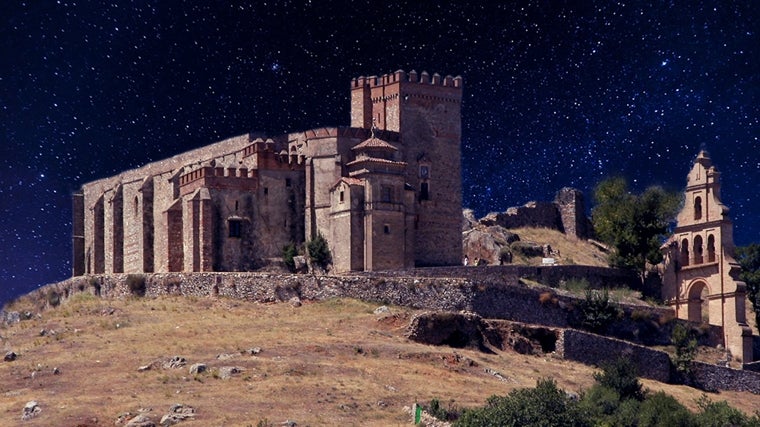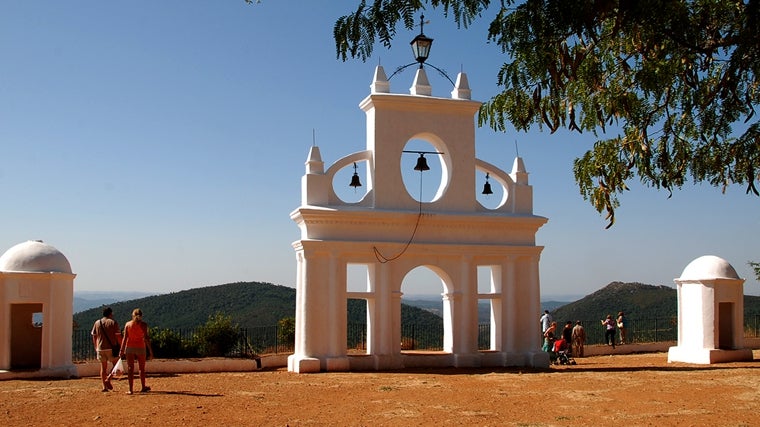From Aracena to Alájar: a route through the coolest villages in Huelva

The Sierra de Aracena and Picos de Aroche Natural Park is a perfect choice for a summer holiday, offering a privileged natural setting, spectacular landscapes of chestnut groves and meadows, mild temperatures, especially at dusk, and excellent cuisine based on Iberian pork products—meat, cured meats, and the finest pata negra ham—as well as the fresh fruit and vegetables provided by the mountain orchards.
 Aracena Castle
BM
Aracena Castle
BM
Among the coolest towns to escape the heat is Aracena, a town where the average daytime temperature in June, July, and August is around 26 degrees. At night, the average temperature is between 15 and 17 degrees. These figures make this municipality in Huelva one of the best places in Andalusia to spend the summer months.
The reasons why Aracena enjoys such pleasant summer temperatures are related to its geographical location. The town is situated at an altitude of 700 meters and is surrounded by lush forests of chestnut, holm oak, and cork oak trees , which play a very important role in the mild climate, as the vegetation helps keep the air cooler thanks to evapotranspiration.
In Aracena, visitors can also enjoy the natural beauty of the Gruta de las Maravillas (Grotto of Wonders), along with world-class heritage sites such as the Castle, the Church of Our Lady of the Assumption, and the architectural gems of Aníbal González , among other monuments, which stand out amidst the well-preserved architecture of the town. In the summer, the town offers numerous activities, festivals, and traditions that have been preserved over time.
Another attractive place to escape the heat is the town of Jabugo, not only because it is one of the representative villages of the "Iberian pig culture," with livestock and industrial activity that has shaped the local way of life since the beginning of the last century, but also because of its climatic conditions and high altitude, which make the enclave an interesting holiday destination, especially in the summer.
Among its monumental buildings, the 18th-century parish church of San Miguel Arcángel stands out, opening onto the Plaza del Jamón with a beautiful doorway. On a nearby hill is the "Tiro de Pichón" (Pichon Shooting Range), whose architecture bears the influence of Aníbal González. From this building, designated as the Center for Innovation and Promotion of Iberian Pork, you can see a vast mountain landscape crisscrossed by the Múrtigas River valley.
To sample the local cuisine, both in Jabugo and in the districts of Los Romeros and El Repilado , hikers can purchase, in addition to cured products such as ham, shoulder and sausages, and fresh products such as sirloin and ribs, some pre-cooked dishes and pâtés, as well as sample the excellence of the cured meats in the bars and restaurants that are distributed throughout each of these population centres.
Nestled within a lush valley, next to the Múrtigas River, the town of Galaroza is an ancient place, as are its orchards and farms. This is evident in the Hermitage of Santa Brígida, one of the town's architectural highlights, built between the 13th and 14th centuries atop a hill. From the summit, there is a splendid panoramic view of the town, nestled among chestnut groves and orchards filled with fruit trees, especially apple trees.
One of Galaroza's attractions is its town center, declared a Historic-Artistic Site. The village preserves the charm of mountain architecture, with cobblestone streets and whitewashed houses adapted to the characteristics of the farmland. On the upper floor, the sunrooms are used as drying sheds or simply for sunbathing. Below, the spacious cellars house food, particularly fruit.
On the walk through the town, the hiker will reach the Plaza de los Álamos, in the central neighborhood of La Fuente . Presiding over the area is the Church of El Carmen, dedicated to the patron saint, which celebrates its festivals in July. Near the square are the centuries-old Fuente de los Doce Caños (Fountain of the Twelve Spouts) and the Fuente de los Jarritos (Fountain of the Jarritos), over whose pond stands a sculpture dedicated to the water festival, held in September.
-U74410313744JDS-760x427@diario_abc.jpg) Fountain of the Twelve Spouts in Fuenteheridos
BM
Fountain of the Twelve Spouts in Fuenteheridos
BM
Another of the hamlets that also remain faithful to the mountain architecture is the town of Fuenteheridos, located between the Alájar valley and the Rivera del Múrtigas, with an urban center that is considered one of the most valuable examples of popular urbanism within the Sierra de Aracena and Picos de Aroche Natural Park, which earned it its declaration as a Historic-Artistic Site in 1982.
In the central Plaza del Coso, where locals and visitors gather in the shade of enormous chestnut trees, stands the Fuente de los Doce Caños (Fountain of the Twelve Spouts). This fountain is considered the source of the Múrtigas River, with a constant flow of two million liters daily. This water is used to supply the town, and after overflowing the fountain, it is used to irrigate the vegetable gardens and to feed the riverbank as it flows downstream.
In the area surrounding the square, you can enjoy a special microclimate, with temperature and humidity levels well below the average for the rest of the town, reaching an average temperature of no more than 18 degrees Celsius in summer. All this is thanks to the abundant water and lush vegetation, which have contributed to transforming the town into a cool and popular holiday haven.
-U82084412828NWj-760x427@diario_abc.jpg) Chestnut of the Oak
BM
Chestnut of the Oak
BM
The presence of extensive chestnut groves and centuries-old cork oaks, typical of a northern landscape, will accompany the traveler along the H-7015 to Castaño del Robledo, a small village located far from the busiest roads, and where the only bustle is the walking of the locals heading to their orchards, or that of the hikers, who throughout the year, and especially on weekends, concentrate on this mountain jewel.
Within the village, declared a historic-artistic site in 1982, the parish church of Santiago el Mayor stands out, a work from the mid-16th century, of which Arias Montano was its first parish priest, and which has the oldest organ in the province (1750) and the New Church, from the 18th century, an unfinished building in neoclassical style, whose work, according to legend, was paralyzed by the death of the builder who directed it, after falling from a scaffold.
At the same time as the new church, the hermitage and shrine of the Lord were built on the old road to Galaroza, as well as the Barrio fountain, very close to the Calvario neighborhood, which displays a large stone coat of arms. Other fountains that refresh the area, such as the Mazorca fountain, behind the Church of Santiago el Mayor, or the Venero fountain, located in El Calvario, constitute, within the architecture of water, other elements of interest for the visitor.
 Arias Mountain Rock in Alájar
bm
Arias Mountain Rock in Alájar
bm
Another holiday destination is Alájar, whose hamlet nestles in the valley at the foot of Peña de Arias Montano (a natural viewpoint filled with forests, grottoes, and fountains, next to the Sanctuary of the Queen of the Angels), and is one of the best-preserved examples of popular architecture in the mountains. Among its hamlet's monuments, the parish church of San Marcos, a Baroque building (18th century), stands out.
However, in addition to the renowned Peña de Arias Montano , Alájar boasts a network of trails with fresh water springs, ever-changing vegetation, and, above all, a peaceful atmosphere. These include the Village Route, the Los Molinos Route, which runs parallel to the Rivera de Alájar, and the path that leads to Linares de la Sierra, where hikers are accompanied by the sound of water and the fragrance of the mountains.
The gastronomic highlight of the route is the varied mountain cuisine of the area, highlighting the charcuterie aspect, linked to the home-slaughtered Iberian pigs, as well as the artisanal production of cheeses and honey. Highlights include cilantro gazpacho, migas (breadcrumbs), and seasonal mushroom dishes. Homemade sweets such as torrijas (French toast), pestiños (fried pestiños), and piñonates (pine nuts) can be the perfect dessert to round off any holiday meal.
ABC.es





